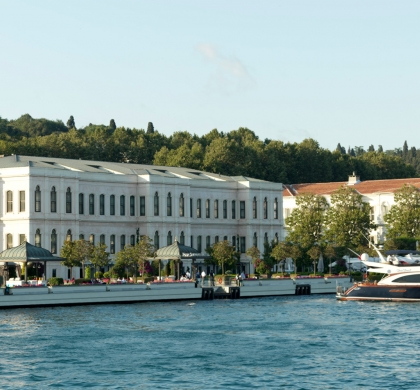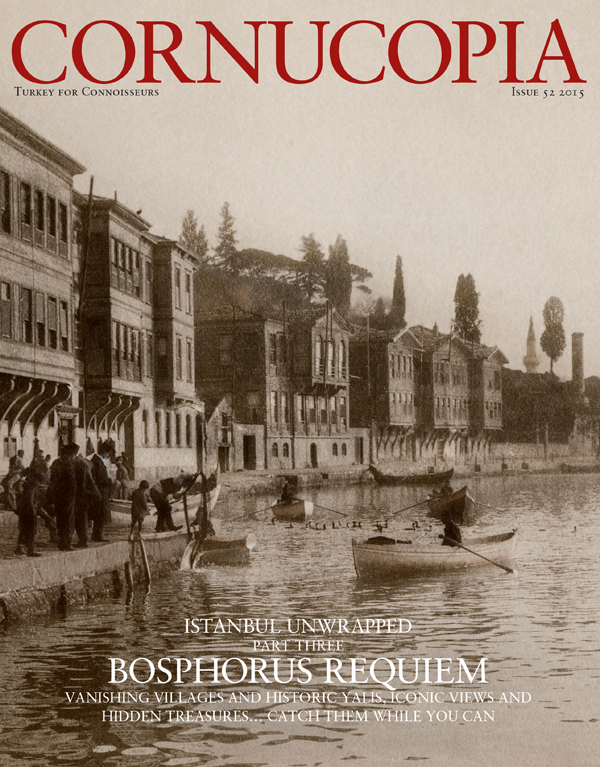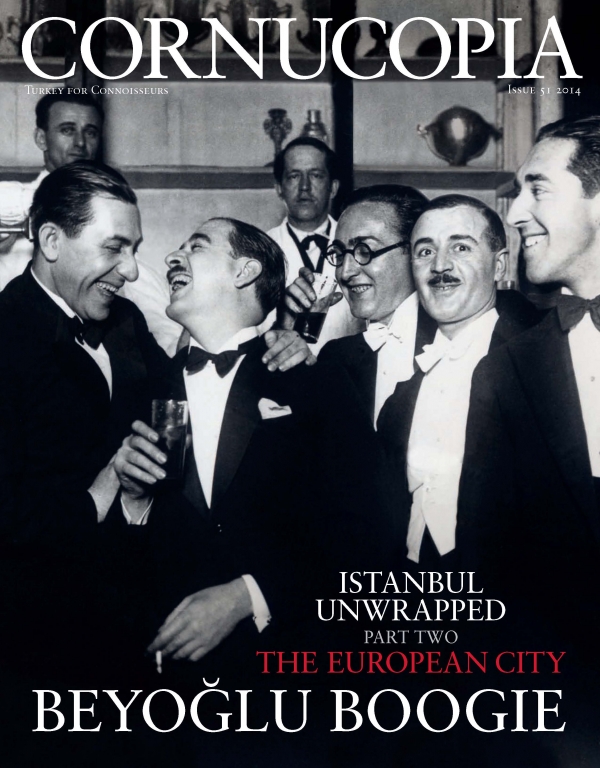Buy or gift a stand-alone digital subscription and get unlimited access to dozens of back issues for just £18.99 / $18.99 a year.
Please register at www.exacteditions.com/digital/cornucopia with your subscriber account number or contact subscriptions@cornucopia.net
Buy a digital subscription Go to the Digital EditionVisitors arriving by water at the sultans’ pavilion of Küçüksu Kasrı could scarcely believe their eyes. As the gates on the Bosphorus swung open, they entered a world of head-turning theatricality, beauty and embellishment – a Dolmabahçe Palace in miniature that charmed a prince. By Berrin Torolsan. Interior photographs by Fritz von der Schulenburg
On a fine spring day in 1862 the future King Edward VII sailed into Istanbul aboard the Royal Yacht Osborne. It was an official visit, but, as the 20-year-old Prince of Wales noted in his journal, “a most agreeable week”. The Prince and his entourage were warmly received by Sultan Abdülaziz, then not a year on the throne, and were entertained at a sumptuous private lunch. Alas, the Prince makes no mention of the menu that day, but the Turkish grandees at the table included the admiral of the fleet and two formidable grand viziers, Fuad Pasha and Aali Pasha (at the time foreign minister). The Prince underlines how impressed he was by the rare honour of his host attending such a large lunch party, which sultans had never been known to do.
The setting for this historic occasion on May 26 was the jewel-like pavilion, the Küçüksu Kasrı, on the Asian shore of the Bosphorus. This imperial lodge stands close to the 14th-century Ottoman fortress of Anadoluhisarı, at the entrance to what was then a lush valley where a broad meadow separated two rippling streams, the Göksu and Küçüksu, known to the West as the Sweet Waters of Asia. Surrounded by mighty planes, ash trees and blue waters, the meadow had for centuries been the favourite beauty spot of Istanbullus. The 17th-century Ottoman traveller Evliya Çelebi described the Göksu as the elixir of life flowing from the mountain behind, surrounded by gardens, where lovers rowed their caiques and rested in the shade of trees. No traveller since has failed to mention the spot in their letters, and no Orientalist artist to make at least one painting of the scene.
This oasis was also popular with sultans. At the start of a golden age of fountain-building, in 1715, water from a spring in the hills was fed down to the imperial hunting lodge and fountains in the village of Anadoluhisarı. In 1806, Selim III erected an exuberantly domed marble fountain on the shore for his picnicking subjects that stands there to this day.
A visit to the Sweet Waters often made a welcome escape from duties of state for his heir, Mahmud II. Mahmud II’s son, the cultured Abdülmecid, who dedicated his life to modernising both his empire and its capital, ordered the old wooden yalı to be replaced by a stone pavilion in the Western manner to complement his Dolmabahçe Palace on the European shore. The new Küçüksu Kasrı, like the Ihlamur Kasrı, built at the same time inland from Dolmabahçe, was a miniature of the palace. The pavilions had neither bedrooms nor hamams, which indicates that they were intended for day visits.
During the reign of Abdülmecid’s brother and successor, Abdülaziz, the restrained Neoclassical exterior – still visible at the back – became more eclectic, with a plethora of Rococo embellishments. Scrolls, acanthus leaves, bunches of grapes, garlands, torches, vases, festoons, fluted columns, all intricately carved in marble and sandstone, were added to the three façades visible from the water. As the 19th-century French writer Théophile Gautier put it, these Bosphorus palaces are “close to the style the Spanish call ‘plateresco’, which makes a monument’s façade resemble a large piece of luxurious gold jewellery, with its profusion of complex ornamentation and mad details”.
Particular attention was paid to the appearance of the buildings from the sea, as transport was by water. Gilded imperial barges, slender mahogany caiques (the sports cars of their day), and taxi caiques with many oarsmen, all glided over the waters, carrying passengers hither and thither. When the magnificent lace-like cast-iron gates swung open, visitors to the Küçüksu Pavilion were greeted with a crescendo of exquisite carving, culminating in a horseshoe staircase, reminiscent of Fontainebleau, surrounding a gleaming marble fountain with an enormous scalloped basin. It was like stepping into a dream.
The architect, Nigoğos Balyan, scion of a dynasty of Istanbul-born contractors, was responsible for many of the new imperial buildings, including Dolmabahçe Palace. His two-storey structure at Küçüksu, built of stone and brick, stands on a stone basement. The upper floors both have the same traditional Turkish floor plan: four interconnected rooms, one in each corner, leading off a central hall or sofa. The waterside rooms are distinguished by curved walls with tall French windows opening onto balconies that make the most of views over the Bosphorus to the fortress of Rumelihisarı on the European shore.
Another flight of double stairs dominates the entrance hall, a sculptural, almost operatic affair with gilt-bronze balusters and a richly adorned circular ceiling. It is the work of Charles Séchan, a Paris set designer turned grand decorator, who worked on theatres all over Europe, from the Paris Opéra to the Musikpavillon in Baden-Baden and the new theatre in Dresden. When the French ambassador to the Porte, the Marquis de La Valette, recommended him to the Francophile Abdülmecid in May 1851, he had just finished the Galerie d’Apollon in the Louvre for Napoleon III. By August, Séchan, assisted by his partner Léon Feuchère and sons-in-law Jules Diéterle and Louis Haumont, was at work decorating and furnishing Dolmabahçe. Gautier tells us that the “illustrious” Séchan’s salon there was decorated in Louis XVI style. The Sultan was delighted with the result and awarded Séchan the ordre du Médjidié.
In a letter from the summer of 1851 ordering architectural plans, drawings and materials, Séchan had warned Diéterle not to use bright yellow as the Sultan hated it. He also slightly ridiculed the imperial taste for pomp – a bit rich given his own penchant for gilded theatricality. By 1858, he had decorated the banqueting hall, the court theatre (pulled down in 1937) and most of the new imperial apartments. Küçüksu’s lavish ceilings have all the Séchan hallmarks: chocolate-box murals of landscapes, drapes, flowers and fruit. The parquetry is also exceptional, with a different pattern in each room that would have set off precious rugs from the imperial looms at Hereke. Fireplaces with surrounds of Italian marble are adorned with ormolu and matching bronze firedogs. Elaborate overmantels with crystal mirrors bear crescents and stars and the Sultan’s cipher. The landscapes and still lifes are framed by richly gilded mouldings on the walls and over the doors.
The emerald-green panes of the glazed doors and the resplendent crystal chandeliers create a magical twinkling effect in the sunlit interiors. Prince Edward thought Dolmabahçe “pretty, & beautifully fitted up”. He was undoubtedly just as impressed by Küçüksu, which he called “charming”.
Küçüksu Kasrı, Cornucopia 54, pp62-63
1) The Prince of Wales’s Journal: 6 Feb-14June 1862
2) Evliya Çelebi Seyyahatnâmesi, haz. Orhan Şaik Gökyay, Vol I, YKY, Istanbul 1996
3) Théophile Gautier
4) ‘Charles Séchan Istanbul’da’ (‘Charles Séchan in Istanbul’) TBMM Milli Saraylar Dergisi Issue 9, 2012, page 234–251, by Claire Vignes-Ducas, translated by Osman Nihat Bişgin
Last Christmas, the art historian Francis Russell escaped the festivities for a hectic week revisiting the Aegean’s most fascinating historic sites, in readiness for a new, enlarged edition of his guide ‘Places in Turkey: A Pocket Grand Tour’. Here is his diary of an action-packed week
The fine art photographer Brian McKee left Istanbul last July to explore the fabled sights of eastern Turkey. Renting a flat in the city of Van, he pored over a weighty survey by the scholar TA Sinclair and followed in his footsteps for 3,000 magnificent kilometres, around Lake Van, and north as far as the old Iron Curtain
Oozing delicious juices, irresistibly moreish, the ‘tirit’ covers a range of traditional Turkish soups and stews, both savoury and sweet, with slices of bread at their heart. Berrin Torolsan serves up the ultimate in comfort food
Istanbul, straddling two continents and sandwiched between two seas, has a thrillingly varied flora which includes many plants seen nowhere else on the planet. Sadly, it is also critically endangered. Text and photographs by Andrew Byfield
Alice Greenway went to Istanbul to study Turkish and learnt to love swimming in the Bosphorus while she was at it
Two weighty tomes on the glories of Iznik pottery. Tim Stanley reviews the magnificent new Iznik book cataloguing the stupendous Ömer Koç Collection and a new study of Iznik’s Damascus offshoot.




Cornucopia works in partnership with the digital publishing platform Exact Editions to offer individual and institutional subscribers unlimited access to a searchable archive of fascinating back issues and every newly published issue. The digital edition of Cornucopia is available cross-platform on web, iOS and Android and offers a comprehensive search function, allowing the title’s cultural content to be delved into at the touch of a button.
Digital Subscription: £18.99 / $18.99 (1 year)
Subscribe now